Creating an "Arc of Crisis": The Destabilization of the Middle East and Central Asia
by Andrew G. Marshall
Global Research, December 7, 2008
Introduction
The recent attacks in Mumbai, while largely blamed on Pakistan’s state-sponsored militant groups, represent the latest phase in a far more complex and long-term “strategy of tension” in the region; being employed by the Anglo-American-Israeli Axis to ultimately divide and conquer the Middle East and Central Asia. The aim is destabilization of the region, subversion and acquiescence of the region’s countries, and control of its economies, all in the name of preserving the West’s hegemony over the “Arc of Crisis.”
The attacks in India are not an isolated event, unrelated to growing tensions in the region. They are part of a processof unfolding chaos that threatens to engulf an entire region, stretching from the Horn of Africa to India: the “Arc of Crisis,” as it has been known in the past.
The motives and modus operandi of the attackers must be examined and questioned, and before quickly asserting blame to Pakistan, it is necessary to step back and review:
Who benefits? Who had the means? Who had to motive? In whose interest is it to destabilize the region? Ultimately, the roles of the United States, Israel and Great Britain must be submitted to closer scrutiny.
The Mumbai Attacks: 11/26/08
On November 26, 2008, a number of coordinated terrorist attacks occurred across India’s main commercial city of Mumbai, which lasted until November 29. The attacks and three-day siege that ensued left hundreds dead, and roughly 295 others injured. Among the dead were a Briton, five Americans and six Israelis.[1]
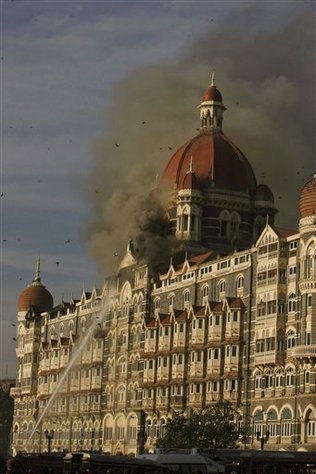
Asserting the Blame
The 60-hour siege that engulfed Mumbai was reportedly undertaken by just ten, well-trained “commando killers.” Most blame has fallen on the heels of the group known as Lashkar-e-Taiba.[2]
At first, a previously-unheard of organization, known as the Deccan Mujahideen, took responsibility for the terror attacks when it sent emails to several news outlets a mere six hours after the fighting began. However, much skepticism remained about whether the group actually even exists.[3]
British intelligence then claimed that the attacks had the “hallmarks” of Al-Qaeda as it was undertaken in an effort to target westerners, similar to the 2002 Bali Bombings. British intelligence officials suggested the attacks were in “retaliation” for the recent US air attacks of suspected Al-Qaeda camps in the Pakistan-Afghanistan border region, and that India was chosen as the target because that is where Al-Qaeda has “sufficient resources to carry out an attack.”[4]
On November 28, India’s foreign minister said the attackers were coordinated “outside the country,” in a veiled reference to Pakistan.[5] India’s Prime Minister also blamed the attacks on militant groups based in Pakistan, which are supported by the Pakistani government.[6]
Then, the focus was put directly on the group, the Lashkar-e-Taiba, a militant Pakistani-based organization responsible for past attacks in India. American intelligence early on pointed the finger at this group, as well as identifying the Pakistani ISI (Inter-Services Intelligence) as its supporter.[7]
The Lashkar-e Taiba (LeT)
It is important to identify what the LeT is and how it has operated historically. The group operates out of the disputed territories between India and Pakistan, Jammu and Kashmir. It has close ties with the Pakistani ISI, and is largely known for its use of suicide attacks. However, aside from its links to the ISI, it is also closely allied with the Taliban and Al-Qaeda. The LeT is even referred to as the “most visible manifestation” of Al-Qaeda in India. It has branches across much of India, Pakistan, and in Saudi Arabia, Bangladesh, South East Asia, and the United Kingdom. It primarily gets its funding from Pakistani businessmen, the ISI and Saudi Arabia. The LeT also took part in the Bosnian campaign against the Serbs in the 1990s.[8]
All the above-mentioned connections make the LeT the most desirable outfit to blame for the Mumbai attacks, as its Al-Qaeda connections, international presence and historical precedents of terror attacks set it up as the perfect target. Much like with Al-Qaeda, the LeT’s international scope could serve as a basis for taking a “war against LeT” to the steps of many countries, thus further serving the interests of the Anglo-American “War on Terror.”
Militant Islam and Western Intelligence – The Case of Yugoslavia
The LeT has not operated independently of Pakistani influence and finances. It’s close relationship with the ISI must be viewed in context: the ISI has a close relationship with Western intelligence agencies, primarily those of Great Britain and the United States. The ISI has effectively acted as a conduit for Anglo-American intelligence operations in the region since the late 1970s, when the Afghan Mujahedeen were created in collusion with the CIA. Out of this collusion, lasting throughout the 1980s until the end of the Soviet-Afghan War in 1989, Al-Qaeda was created, as well as a series of other militant Islamic organizations.
It is often stated that the CIA then discontinued its relationship with the ISI, and in turn, that the militant Islamic organizations broke off from their Western intelligence sponsors to declare war against the West. However, the facts do not support this. The ties remained, but the strategy changed. What changed was that in the early 1990s, the Cold War ended, and Russia no longer was the “Evil Empire,” and thus the excuse for an exacerbated defence budget and imperialist foreign policy receded. As George H.W. Bush declared, it was during this time that we would see the formation of the “New World Order.” And with that, there was a need for a new, elusive enemy, not in the form of a nation, but a seemingly invisible enemy, international in scale, thus taking the war to an international arena.
So in the early 1990s, Western intelligence maintained its ties to these Islamic terrorist groups. Yugoslavia is a very important case to analyze in relation to current events. The break-up of Yugoslavia was a process undertaken by Anglo-American covert interests with the aim of serving their imperial ambitions in the region. In the early 1980s, the IMF set the stage in Yugoslavia with its Structural Adjustment Programs, which had the effect of creating an economic crisis, which in turn created a political crisis. This exacerbated ethnic rivalries, and in 1991, the CIA supported the Croat move for independence.
In 1992, with the start of the Bosnian War, Al-Qaeda-affiliated terrorists began operating with the ethnic Bosnian Muslim minority in fighting the Serbs. In turn, these Al-Qaeda affiliated groups were supported with training, arming, and finances by German, Turkish, Iranian and US intelligence agencies; with additional financial support from Saudi Arabia. In 1997, the Kosovo War began, in which the militant-terrorist-drug trafficking Kosovo Liberation Army (KLA) began fighting against Serbia, with training, arms and financial support from the US and other NATO countries. The CIA, German intelligence, the DIA, MI6 and British Special Forces (SAS) all provided training and support to the KLA.
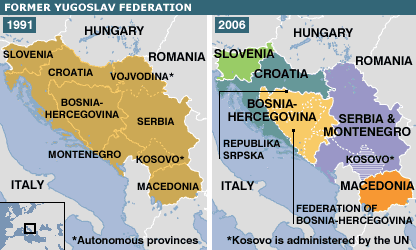
Yugoslavia - Before and After Balkanization
The aim was in breaking up Yugoslavia, using ethnic rivalries as the trigger for regional conflict and ultimately war, leading to the dissolution of Yugoslavia into several countries, justifying a permanent US and NATO military presence in the region. [See: Breaking Yugoslavia, by Andrew G. Marshall, Geopolitical Monitor, July 21, 2008]
The Lashkar-e Taiba’s participation in the Bosnian War against Serbia would have in turn been financed and supported by these various Western intelligence agencies, thus serving the interests of Western Imperialist states; primarily those of Great Britain and the United States.
The LeT and Western Intelligence
The LeT has a sordid history of involvement with Western intelligence agencies, primarily those of Great Britain.
With the London 7/7 bombings [July 7, 2005] in which three underground stations and a double-decker bus had bombs explode on them; many of the suspected terrorists had interesting connections to Pakistan. For example, one of the suspects, Shehzad Tanweer, had apparently “attended a religious school run by the terrorist group Lashkar-e-Taiba (LeT)” while in Pakistan. Due to the LeT’s ties with Al-Qaeda, this allowed for the conclusion to be drawn that Al-Qaeda may have played a part in the London bombings, which were initially blamed on the international terrorist organization. The LeT also has close ties with the Jemaah Islamiyyah (JI),[9] an Indonesian terrorist organization, which was blamed for the 2002 Bali bombings, which also targeted tourists in Indonesia.
The Bali Bombings
Interesting to note, however, is that in the early 1990’s, when the Jemaah Islamiyyah (JI) was officially formed into a terrorist organization, it developed close ties with Osama bin Laden and Al-Qaeda. Further, the organizations founders and leaders played a significant role in recruiting Muslims to join the Afghan Mujahideen in the war against the Soviets during the 1980’s, which was covertly directed and supported by US, British and various other Western intelligence agencies. The JI wouldn’t exist “without the CIA’s dirty operations in Afghanistan.” A former Indonesian President stated that one of JI’s key individuals was also a spy for the Indonesian intelligence agency, and that Indonesian intelligence played a more central role in the Bali bombings than the JI itself.
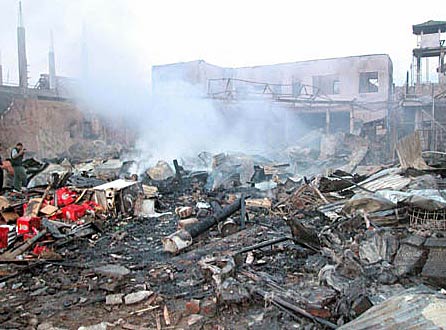
Bali Bombings
The JI itself, had reportedly been infiltrated by the CIA, Israeli Mossad, and that “the CIA and the Mossad, assisted by the Australian Special Action Police (SAP) and the M15 of England, are all working towards undermining Muslim organizations in an attempt to weaken the Muslims globally.” Further, one of JI’s key planners of the Bali bombings, Omar al-Faruq, was reportedly a CIA asset, and even senior Indonesian intelligence officials believed the CIA was behind the Bali bombings. The CIA subsequently “guided” Indonesia’s investigation into the bombings, which found the JI, and the JI alone, responsible for the attacks. [See: Andrew G. Marshall, The Bali Bombings. Geopolitical Monitor, November 15, 2008]
London 7/7
Much of the focus of the London bombings of July 7, 2005 (7/7), was focused on the “Pakistani connection.” The suspected bombers had all visited Pakistan, and apparently developed contacts with groups such as Jaish-e-Mohammed and the Lashkar-e Taiba. However, a less known and less publicized connection yields some very interesting information. The suspected mastermind of the London bombings, Haroon Rashid Aswat, had visited all the suspected bombers leading up to the attacks. Phone records revealed that there were “around 20 calls between him and the 7/7 gang, leading right up to those attacks.” Why is this significant? Because Haroon Rashid Aswat, apart from being an Al-Qaeda operative, also happened to be an MI6 agent, working for the British intelligence. Haroon also made his appearance on the scene of Islamic terrorism when he was in Kosovo in the 1990’s, where he “worked for British intelligence.”[10]
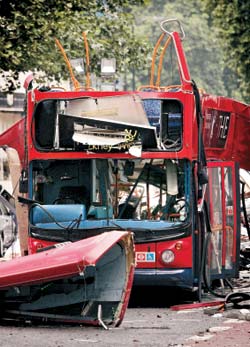
The Liquid Bomb Plot
Another event which brought to the forefront a “Pakistani connection” was the August 2006 London liquid bomb plot, in which terrorists supposedly were plotting to blow up nearly a dozen Atlantic airliners bound for major US cities.
The Pakistani ISI apparently helped in “uncovering” the liquid bomb plot, aiding the British in their roundup of suspects, and “tipped-off MI5.” One of the Pakistani groups accused of some involvement in the liquid bomb plot was the Lashkar-e Taiba.[11]
However, again, the suspected terrorists had been “infiltrated” and spied on by British intelligence for over a year. Further, the supposed ringleader of the bomb plot, Rashid Rauf, a dual British-Pakistani citizen, was pinpointed as the ringleader by both British and Pakistani intelligence, and was the link between the plot and Al-Qaeda. Rauf also has close ties with the ISI, and apparently had the plot approved by Al-Qaeda’s number two in command, Ayman al-Zawahiri, who formerly worked for the CIA during the Soviet-Afghan war. The ISI had arrested Rashid Rauf following the “exposure” of the liquid bomb plot, yet, in 2006, the charges against him were dropped, and in 2007, he amazingly escaped Pakistani custody, having “managed to open his handcuffs and evade two police guards.” [See: Andrew G. Marshall, Liquid Bomb Plot. Geopolitical Monitor: October 27, 2008]
Clearly, if the LeT is discovered to be responsible for the Mumbai attacks, its connections to Western intelligence agencies should be more closely examined and subject to investigation. The ISI, throughout its history, has not been the key player in supporting various terrorist organizations, rather, it can be more accurately described as a conduit for Western intelligence agencies to covertly fund and support terrorist organizations in the Middle East and Central Asia.
Terrorizing India
We must examine the current attacks with a backdrop of reviewing recent terror attacks in India.
1993 Bombay Bombings
March 12, 1993, Bombay (today, Mumbai) experienced a coordinated attack of 13 explosions, which killed over 250 people. A man with close connections to Osama bin laden and Al-Qaeda, Dawood Ibrahim, was believed to have been the mastermind of the attacks. He has also financed several operations of the Lashkar-e Taiba, and was believed to be hiding out in Pakistan, and receiving protection and support from the Pakistani ISI, which in 2007, reportedly arrested him. [See: Andrew G. Marshall, Political Destabilization in South and Central Asia: The Role of the CIA-ISI Terror Network. Global Research: September 17, 2008]
Mumbai Bombings, July 11, 2006: 7/11
Over 200 people were killed in Mumbai when seven bombs exploded within 11 minutes of one another on several trains. Blame for the attacks was placed with the Students Islamic Movement of India (SIMI) and the Lashkar-e Taiba (LeT), both of which have close ties with the ISI. The ISI was subsequently blamed for organizing the attacks, which were then carried out by the LeT and SIMI. The bombings led to the postponement of India-Pakistan peace talks, which were set to take place the next week. [Ibid]
Indian Embassy Bombing in Kabul, Afghanistan: July 7, 2008
On July 7, 2008, a bomb exploded at the Indian embassy in Kabul, Afghanistan, killing over 50 people, and injuring over 100 others. The Afghan government and the Indian intelligence agency immediately blamed the ISI, in collaboration with the Taliban and Al-Qaeda, of planning and executing the attack. Reports on the bombing suggested that the aim was to “increase the distrust between Pakistan and Afghanistan and undermine Pakistan's relations with India, despite recent signs that a peace process between Islamabad and New Delhi was making some headway.”
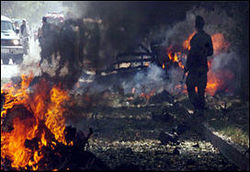
Indian Embassy in Kabul
In early August, American intelligence agencies supported the claim that members of the ISI helped plan the attack, which they based upon “intercepted communications,” and that, “American officials said that the communications were intercepted before the July 7 bombing, and that the C.I.A. emissary, Stephen R. Kappes, the agency’s deputy director, had been ordered to Islamabad, Pakistan’s capital, even before the attack.” Interestingly, “a top Central Intelligence Agency official traveled to Pakistan [in August] to confront senior Pakistani officials with information about support provided by members of the ISI to militant groups.” However, the CIA knows of these connections, as it has actively supported and financed these covert ISI connections with terrorist organizations. So, what was the real purpose of this top CIA official’s visit to Pakistan?
Days after the CIA released this information to the New York Times, the US accused Pakistan of undermining NATO’s efforts in Afghanistan by supporting Al-Qaeda and the Taliban, and further, “Mike Mc-Connell, the director of national intelligence, and [CIA director] Hayden asked Musharraf to allow the CIA greater freedom to operate in the tribal areas,” and was threatened with “retaliation” if he did not comply. [See: Andrew G. Marshall, Political Destabilization in South and Central Asia: The Role of the CIA-ISI Terror Network. Global Research: September 17, 2008]
The ISI and the CIA
Again, if the ISI is to be blamed for the recent Mumbai attacks, as it has played a part in several attacks and support of terrorism throughout its history, it is important to identify its relationship with the CIA.
The CIA developed close ties with the ISI in the late 1970s, as the CIA used the ISI as a “go-between” for CIA support of the Afghan Mujahideen. This relationship was also pivotal in supporting the Afghan narcotics trade, which again is rampant. The relationship between the two agencies continued throughout the 1990s, in areas such as Chechnya, Yugoslavia and India. [See: Michel Chossudovsky, Al Qaeda and the "War on Terrorism". Global Research: January 20, 2008]
A week prior to the 9/11 attacks, the head of Pakistan’s ISI was on a visit to Washington, D.C., where he met with several key policy figures, such as Deputy Secretary of State, Richard Armitage; Senator Joseph Biden, who is going to be Obama’s Vice President; and with his counterparts in the CIA and Pentagon, and several other officials. He was in Washington right up to and after the 9/11 attacks, and was engaged in several key consultations with US officials, pledging support for the US War on Terror instantly. However, the very same Chief of the ISI also happened to have previously approved of wiring $100,000 to the lead 9/11 hijacker, Mohammed Atta, which was also confirmed by the FBI. Thus, the ISI suddenly became a financier of the 9/11 attacks. Yet, no action was taken against the ISI or Pakistan, apart from the ISI Chief being fired upon this revelation making it into the media.
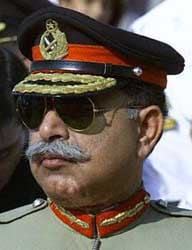
ISI Chief Lt.-General Mahmoud Ahmad
Of significance is that this ISI Chief, Lt.-General Mahmoud Ahmad, was approved as head of the ISI by the US in 1999. From then, he was in close contact and liaison with top officials of the CIA, the Defense Intelligence Agency (DIA), and the Pentagon. [See: Michel Chossudovsky, Cover-up or Complicity of the Bush Administration? Global Research: November 2, 2001]
Collaboration between the ISI and CIA did not end with these disturbing revelations. In 2007, it was reported that the CIA was arming and funding a terrorist organization named Jundullah, based in Pakistan’s tribal areas, with the goal of “sowing chaos” in Iran. Jundullah not only is funded and armed by the CIA, but has extensive ties to Al-Qaeda, and the ISI, as the CIA’s financial support for the group is funneled through the ISI, so as to make it more difficult to establish a link between the CIA and the terrorist outfit. [See: Andrew G. Marshall, Political Destabilization in South and Central Asia, op cit ]













